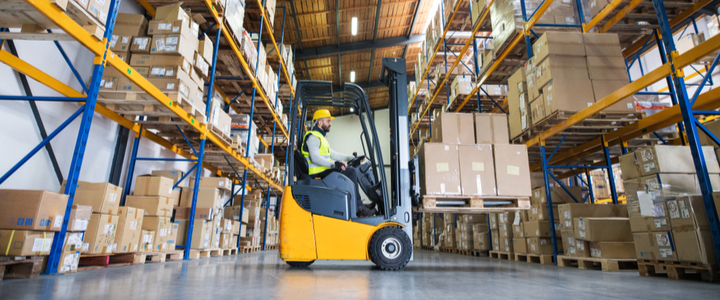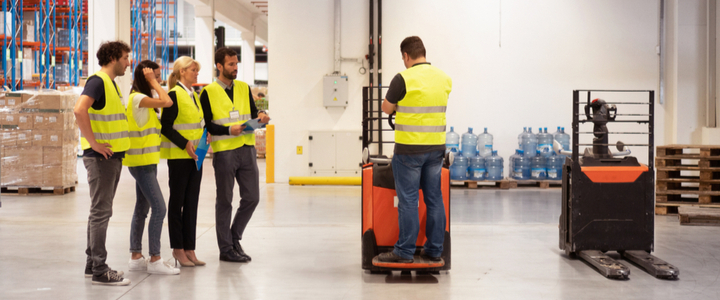Working with a forklift is vigorous work, and not everyone can do it. In order to use a forklift, the operator needs to be certified and have a high-level understanding of OSHA forklift safety and training. Getting behind the wheel without proper training can result in accidents, injuries, and workplace catastrophes.
Here are the 12 forklift hazards in the warehouse to be aware of:
- Improper Use
- Blind spots
- Unsecured Loads
- Improper Maintenance
- Docks & Ramps
- Fueling
- Speed
- Pedestrians
- Attachment Hazards
- Overhead Obstructions
- Seatbelts & Tethers
- Floor Conditions
If you are in an industry that requires forklifts for heavy materials, you need to understand the risks and hazards of your job. Employers should always complete a forklift hazard risk assessment before letting the machine be used in a new area. Forklift operation safety is imperative for the well-being of everyone involved.
List of 12 Forklift Hazards & Solutions
If you are working with a forklift or training others to work with the machinery, you will want to understand all of the risks and help them understand too. The more you know and are aware, the more you can limit risks and find solid solutions. You will want to teach your team forklift maneuvering, how to drive a forklift down a ramp, driving a forklift with an obstructed view, and forklift ramp safety. This is your responsibility when you run a team.
1. Improper Use
There is an OSHA formal training program that each individual should follow. However, certain people will still misuse a forklift. Some people may try to race, take sharp turns, or use the forklift in destructive ways. Racing can lead to severe injuries, and many forklift blind spots could cause danger for someone else.
The Solution
Ensure proper training by OSHA standards. Any person who is operating should have a certificate claiming that they know how to handle this machinery. This is the law, and you must follow it.
2. Blind spots
As mentioned above, forklift blind spots are dangerous. If the user of the equipment is not careful, pedestrians can be harmed. Frequently when the forklift is carrying something large and heavy, the driver’s view is obstructed, and they are not able to see directly in front of them. In these cases, the operator should drive the forklift in reverse.
The Solution
Ensure that the pedestrians know where the blind spots of a forklift are and limit the traffic while the forklift is being used. You should also make sure the person operating the machine is comfortable driving backward.
3. Unsecured Loads
Every forklift has a weight limit and individual attachments. There will be clasps and backrests; nothing on the load should feel loose or wobbly. Anything unsecured could fall and hurt someone badly.
The Solution
Ensure that everyone on the team knows how to secure a load with straps if necessary. Be sure to teach your team how much weight a forklift can carry as well.
4. Improper Maintenance
Believe it or not, like any other piece of machinery, a forklift needs maintenance. Without maintenance, there is a forklift risk. Worn forks, broken lights, broken alarms, or bad chains can be a serious hazard when using this equipment.
The Solution
After a few uses, you should always inspect your forklift. Before anyone uses the equipment, a set of tests and assessments should be done to understand if it has been adequately maintained. If you notice anything wrong, no one should use it until the problem is fixed.
5. Docks & Ramps
If you are getting tons of shipments, chances are you will use a forklift to get things from the truck into your facility. All operators should understand forklift truck health and safety. They should also know about lift truck safety. The ramps and lift on the trucks will need to be operated, and if the docks or ramps are not set up correctly, it could be dangerous.
The Solution
Every machine operator who uses the forklift should be aware of how to use docks, ramps, and truck lifts. If a forklift operator does not know how to do that, pair them with someone who is comfortable with the other ramps. Training and teaching are crucial.
6. Fueling
The recharging area can be incredibly hazardous because of the gas or other chemicals involved in recharging the forklift. Diesel and propane are both extremely flammable and could cause fires or explosions.
The Solution
Be sure the entire staff knows to never smoke near the recharging station. However, you should also be aware of where most of the team smokes or where anything is lit up, and designate your charging station away from those areas. It’s all about having a proper design!
7. Speed
Forklifts are incredibly heavy, and even at a slow speed, they can cause as much damage as a car going 15mph. The speed and weight of the forklift could potentially be impeccably dangerous for anyone walking around.
The Solution
When the forklift is in motion, the operator should be aware of the surrounding environment. Consider designating a lookout person. The people walking around should also understand to stay out of the forklift zone to prevent accidents. You can create a pedestrian-only area if needed.
8. Pedestrians
Pedestrians are a common theme throughout this article, and that’s because anyone unaware of a zone they’re in can potentially cause a dangerous situation. Pedestrians themselves may cause accidents, or the forklift might try to maneuver around them and end up somewhere it’s not supposed to be.
The Solution
Always keep safety tape marking where any non-essential employees can and cannot walk. Make it clear where the forklift can and can’t go. Using direct signs for the people walking around can save a lot of accidents from happening.
9. Attachment Hazards
Most forklifts have many different kinds of attachments that can be used. However, like the entire machine, if these are not properly put on or maintained, they can cause some serious workplace injuries.
The Solution
Ensure that the operator understands how to add the attachments safely for the best results. Before using any attachments, be sure that they have been well maintained and inspected before use.
10. Overhead Obstructions
If any low ceilings or objects are hanging from the above, this could cause a dire situation. It could collide with whatever the forklift is carrying, or the forklift may not fit, causing other problems.
The Solution
Always mark where the forklift can and cannot go. If there are any lower ceilings, mark their height for the operator. Different sized forklifts will know what the size of their machine is.
11. Seatbelts & Tethers
Seatbelts or tethers that harness around the person operating the forklift should always be well maintained. If they are worn out or are too loose, this could be life-threatening for the operator.
The Solution
Ensure that the seat belts are snug enough to keep the operator strapped in at all times. This may seem like a nuisance for the driver, but it is for safety reasons.
12. Floor Conditions
Uneven floors or other places that have not been paved correctly may cause damage to the forklift. Surfaces that are wet, slippery, or cluttered with debris could cause problems for the forklift.
The Solution
You will want to ensure that the floors are clear and clean before allowing any moving machinery to roam about the facility. Housekeeping is crucial to maintain proper safety.
Avoid Forklift Hazards with Guidance from Safety By Design
If you are looking for more training or have other safety-related questions, we are the company for you. We’ll guide you through OSHA’s general safety standards and help you train your staff to ensure the safety of others.
Contact our team today to discuss training or consulting options that make sense for your needs!






